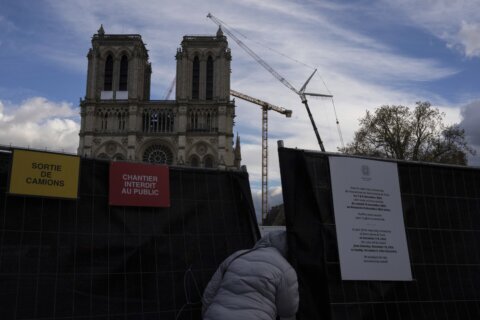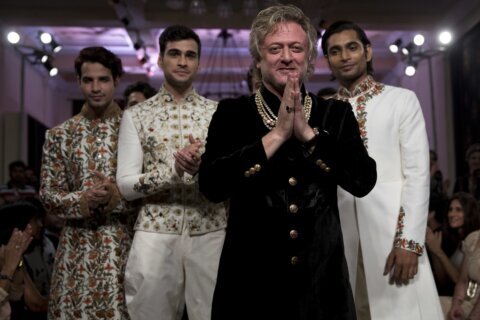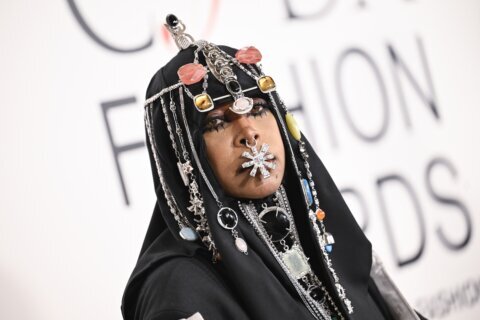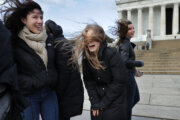NEW YORK (AP) — Weaver and designer Dorothy Liebes helped define the look and feel of 20th century luxury, from first-class airline seats to movie backdrops, hotel suites to bathing suits, metallic wallpaper to car upholstery.
She was a name, but unlike so many of the leading architects and designers with whom she worked, including Frank Lloyd Wright, Henry Dreyfuss and Donald Desky, her fame has dimmed since her death in 1972.
An eye-popping exhibit at the Cooper Hewitt Smithsonian Design Museum takes a giant step toward changing that, revealing the breadth and impact of Liebes’ work through dozens of textiles, fashion pieces, furniture, documents and photos.
Liebes was a master of color, texture, marketing and bling for decades, starting in the 1930s.
“She pioneered a new role for the textile designer as a partner to industry,” says Susan Brown, the museum’s associate curator and acting head of textiles, who co-organized the exhibit with Alexa Griffith Winton, manager of content and curriculum.
“A Dark, a Light, a Bright: The Designs of Dorothy Liebes,” which organizers say is the first exhibit devoted solely to her in over 50 years, opened in July and runs through Feb. 4, 2024. The title is taken from a Liebes rule for designing textiles, which produced vibrant results, particularly when viewed from today’s tendency toward neutrals and muted shades.
Liebes collaborated not just with architects and designers but with major brands like Lurex and DuPont.
“She had a sense early on of the importance of textiles in interior design. She also knew how to read a blueprint, and she had a very analytical perspective. In a different decade, she might have become an architect,” says Winton.
In addition to her design expertise, Liebes could communicate it. She frequently appeared on television and in magazines, and mentored young weavers and designers in her studios in California and, later, New York.
`WHAMEROO’ COLOR AND GLITTER
Among highlights of the show are the brave — and bright — blue and green color combination in the first-class observation lounge of the ocean liner S.S. United States. There are the brilliant reds and blues of the first-class seating on American Airlines flagship 747; the glamorous textile backdrops of the 1947 film “Eastside, Westside”; and the dazzling upholstery of the 1957 Chrysler Plymouth Fury.
There also are Liebes’ collaborations with fashion designers Clare Potter and Bonnie Cashin, revealing the frequent interplay between fashion and interior design.
“There is nothing like what I call a ‘whameroo’ color to make the whole thing come alive,” Liebes told Potter when Potter said she loved the way Liebes would “inject something startling” in her work.
“Don’t be afraid of color,” Liebes said. “Color is heady stuff, and the more one lives with it (as the 20th century man does), the more one can digest. After all, it isn’t the color, but the combination of colors and values.”
She was equally enthusiastic about infusing her work with flashes of bling, which she saw as something essential: “Glitter is what the sun does to grass, what light does to nature.”
The idea of using small items like throw pillows to add pops of color to an interior is a direct legacy of Liebes’ influence, the curators say.
A MODERN MIX OF HANDWOVEN, POWER-LOOMED
Some of Liebes’ early works include a Schiaparelli panel created for the 1937 Paris Exposition, and objects linked to the 1939 Golden Gate Exposition, where she began articulating her vision for the role of handcraft in modern design.
The exhibit also showcases her contributions to creating dazzling public spaces on a budget by combining handwoven and power-loomed textiles. There are saturated brilliant colors and extensive use of metallics. Examples are the Persian Room of the Plaza Hotel (where textile panels were embedded with tiny lightbulbs); the Marco Polo Club at the Waldorf Astoria; and the Usonian Exhibition House, built on the site where the Guggenheim Museum now stands.
And Liebes helped create consumer goods, including tiles and wallpaper. She had a hand in industry’s development of synthetic materials, and worked to encourage their use by both top designers and consumers.
Lurex woven fabrics, for example, in dazzling jewel tones designed to look handwoven, were favored for swimwear and raincoats, as well as washable clothing.
THE ROOM WHERE IT HAPPENED
Finally, the exhibit gives a sense of the creative process at Liebes’ weaving studios. Her bright red personal loom is on view, with a partially woven textile still on it. There are also handwoven samples exploring colors and textures, and photos of her studio teams at work.
After her death, her works were scattered among various museums, including the Art Institute of Chicago, the Oakland Museum of California, The Metropolitan Museum of Art, and the Museum of Arts and Design, as well as the Cooper Hewitt.
—- For more on the exhibit, explore it digitally at https://exhibitions.cooperhewitt.org/dorothy-liebes/, or see the companion book edited by Brown and Winton (Yale University Press in association with Cooper Hewitt, 2023).
—-
For more AP stories on design, go to https://apnews.com/hub/design.
Copyright © 2024 The Associated Press. All rights reserved. This material may not be published, broadcast, written or redistributed.







